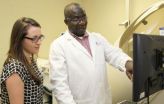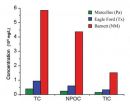(Press-News.org) A new study reports that an expansion of marine protected areas is needed to protect fish species that perform key ecological functions. According to investigators from the Wildlife Conservation Society and other organizations, previous efforts at protecting fish have focused on saving the largest numbers of species, often at the expense of those species that provide key and difficult-to-replace ecological functions.
Many vital ecological functions of ocean ecology are performed by fish species that also are food for millions of people. This study uncovers a significant problem: the world's most ecologically valuable fish communities are currently vulnerable and are being missed by the world's current network of marine protected areas. If these tropical fish populations and the ecological services that they provide are to be ensured, say the authors, then the world's existing marine protected area network must be expanded. The paper appears in the current online edition of Ecology Letters.
"The recognition that all species are not the same and that some play more important and different roles in ocean ecology prompted this new investigation. The study was expected to identify regions with vulnerable fish populations, something that has been sidetracked by the past species richness focus," said Dr. Tim McClanahan, WCS Senior Conservationist and a co-author of the study. "If you lose species with key functions, then you undermine the ability of the ocean to provide food and other ecological services, which is a wake up call to protect these vulnerable species and locations. Our analysis identifies these gaps and should provide the basis to accelerate the protection of ocean functions."
The authors of the study compiled a global database on tropical coastal fish populations from 169 locations around the world, focusing on species occurring in 50 meters of water or less. The team compared these data with distribution maps for 6,316 tropical reef fish species. Human threats such as fishing, pollution, and climate change were also included in the analyses.
What the authors found was that many areas with threatened but functionally important fish were found outside of existing marine protected areas. Also, the study examined other vulnerabilities such as taxonomic sensitivity (the number of threatened species in a fish assemblage or community) and functional sensitivity (the number of functions in danger of being lost because of external threats).
From a regional perspective, the analysis revealed that species richness "hotspots" are located in the Indo-Australian Archipelago and the Caribbean. Species-rich areas for short-ranged fish were located in peripheral zones in the Atlantic as well as the Indo-Pacific.
Areas of high vulnerability included the coastal waters of Chile, the eastern tropical Pacific, and the eastern Atlantic Ocean, areas where comparatively few fish species perform vital environmental functions with few or no redundancies or species that fill similar roles.
"Protecting the ecological services that fish populations provide for coastal habitats is as important as protecting wildlife species themselves," said Dr. Caleb McClennen, Executive Director of WCS's Marine Program. "This decision theory framework can help marine managers make recommendations about where to place marine protected areas that expand and protect the ocean's ability to provide key services."
INFORMATION:
The authors of the study are: Valeriano Parravicini of the Institut de Recherche pour le Développement, Domaine du Petit Arbois, and the University of Perpignan; Sébastian Villéger of the Laboratoire Ecologie des Systèmes Marins Côtiers; Tim McClanahan of the Wildlife Conservation Society; Jesus Ernesto Arias-González of the Laboratorio de Ecología de Ecosistemas de Arrecifes Carolinos; David R. Bellwood of James Cook University; Jonathan Belmaker of Tel Aviv University; Pascale Chabanet of the Institut de Recherche pour le Développement; Sergio R. Floeter of the Universidade Federal de Santa Catarina; Alan M. Friedlander of the University of Hawaii at Manoa; François Guilhaumon of the Laboratoire Ecologie des Systèmes Marins Côtiers; Laurent Vigliola of the Institut de Recherche pour le Développement; Michel Kulbicki of the Institut de Recherche pour le Développement; and David Mouillot of the Laboratoire Ecologie des Systèmes Marins Côtiers and James Cook University.
Study finds marine protected areas inadequate for protecting fish and ocean ecology
2014-08-28
ELSE PRESS RELEASES FROM THIS DATE:
NASA's TRMM analyzes Hurricane Cristobal
2014-08-28
VIDEO:
TRMM satellite passed over Cristobal on Aug. 27 at 8:16 a.m. EDT. Cristobal didn't appear round and symmetric in either clouds or rainfall which suggests that the hurricane is being...
Click here for more information.
NASA's Tropical Rainfall Measuring Mission or TRMM Satellite provided a look under the hood of Hurricane Cristobal as it continues moving north and paralleling the U.S. East Coast. NASA's HS3 hurricane mission also investigated the storm. Cristobal is now ...
A new, tunable device for spintronics
2014-08-28
Spin-charge converters are important devices in spintronics, an electronic which is not only based on the charge of electrons but also on their spin and the spin-related magnetism. Spin-charge converters enable the transformation of electric into magnetic signals and vice versa. Recently, the research group of Professor Jairo Sinova from the Institute of Physics at Johannes Gutenberg University Mainz in collaboration with researchers from the UK, Prague, and Japan, has for the first time realised a new, efficient spin-charge converter based on the common semiconductor material ...
New analysis of old HIV vaccines finds potentially protective immune response
2014-08-28
DURHAM, N.C. – Applying the benefit of hindsight, researchers at Duke Medicine have reanalyzed the findings of two historic pediatric HIV vaccine trials with encouraging results. The vaccines had in fact triggered an antibody response -- now known to be associated with protection in adults -- that was previously unrecognized in the infants studied in the 1990s.
Reporting online Aug. 28, 2014, in the Journal of Infectious Diseases, the Duke researchers relied on fresh insights that have been gleaned from a recent adult HIV vaccine trial in which the vaccine reduced the ...
New tool aids stem cell engineering for medical research
2014-08-28
ROCHESTER, Minn. — A Mayo Clinic researcher and his collaborators have developed an online analytic tool that will speed up and enhance the process of re-engineering cells for biomedical investigation. CellNet is a free-use Internet platform that uses network biology methods to aid stem cell engineering. Details of CellNet and its application to stem cell engineering are described in two back-to-back papers in the journal Cell.
"This free platform has a broad range of uses for all types of cell-based investigations and can potentially offer help to people working on all ...
UMN researchers find animal model for understudied type of muscular dystrophy
2014-08-28
MINNEAPOLIS/ST. PAUL (August 28, 2014) – Researchers at the University of Minnesota have developed an animal research model for facioscapulohumeral muscular dystrophy (FSHD) to be used for muscle regeneration research as well as studies of the effectiveness of potential therapies for FSHD.
The research is published in the current edition of the journal Cell Reports.
There is no treatment for FSHD, which is thought by many to be the most common type of muscular dystrophy. FSHD is an unusual genetic disorder because, unlike most genetic diseases, it is not caused by the ...
Breastfeeding study shows need for effective peer counseling programs
2014-08-28
Athens, Ga. – The support of peer groups and clinicians is critical to the development of effective breastfeeding programs, according to recent University of Georgia research.
A qualitative study of 21 mothers in the Athens-Clarke County area determined that role models for successful breastfeeding help positively shape the outcomes of mothers of infants.
"Mothers who received that support are more likely to be successful at breastfeeding," said study co-author Alex Anderson, an associate professor in the College of Family and Consumer Sciences department of foods and ...
New solutions needed to recycle fracking water
2014-08-28
HOUSTON – (Aug. 28, 2014) – Rice University scientists have produced a detailed analysis of water produced by hydraulic fracturing (aka fracking) of three gas reservoirs and suggested environmentally friendly remedies are needed to treat and reuse it.
More advanced recycling rather than disposal of "produced" water pumped back out of wells could calm fears of accidental spillage and save millions of gallons of fresh water a year, said Rice chemist Andrew Barron, who led the study that appeared this week in the Royal Society of Chemistry journal Environmental Science: ...
Females ignored in basic medical research
2014-08-28
CHICAGO --- A new study from Northwestern Medicine® has found that surgical researchers rarely use female animals or female cells in their published studies -- despite a huge body of evidence showing that sex differences can play a crucial role in medical research.
Editors of the five major surgical journals reviewed in this study have responded to this finding and will now require authors to state the sex of animals and cells used in their studies. If they use only one sex in their studies, they will be asked to justify why.
"Women make up half the population, but ...
UTHealth researchers find up to 3,000 times the bacterial growth on hollow-head toothbrushes
2014-08-28
HOUSTON – (Aug. 28, 2014) — Solid-head power toothbrushes retain less bacteria compared to hollow-head toothbrushes, according to researchers at The University of Texas Health Science Center at Houston (UTHealth) School of Dentistry.
The results of the study are published in the August issue of the Journal of Dental Hygiene. Lead author and professor at the UTHealth School of Dentistry, Donna Warren Morris, R.D.H., M.Ed., notes that microbial counts were lower in the solid-head toothbrush group than in the two hollow-head toothbrush groups in 9 out of 10 comparisons.
"Toothbrushes ...
Together, humans and computers can figure out the plant world
2014-08-28
As technology advances, science has become increasingly about data—how to gather it, organize it, and analyze it. The creation of key databases to analyze and share data lies at the heart of bioinformatics, or the collection, classification, storage, and analysis of biochemical and biological information using computers and software. The tools and methods used in bioinformatics have been instrumental in the development of fields such as molecular genetics and genomics. But, in the plant sciences, bioinformatics and biometrics are employed in all fields—not just genomics—to ...





